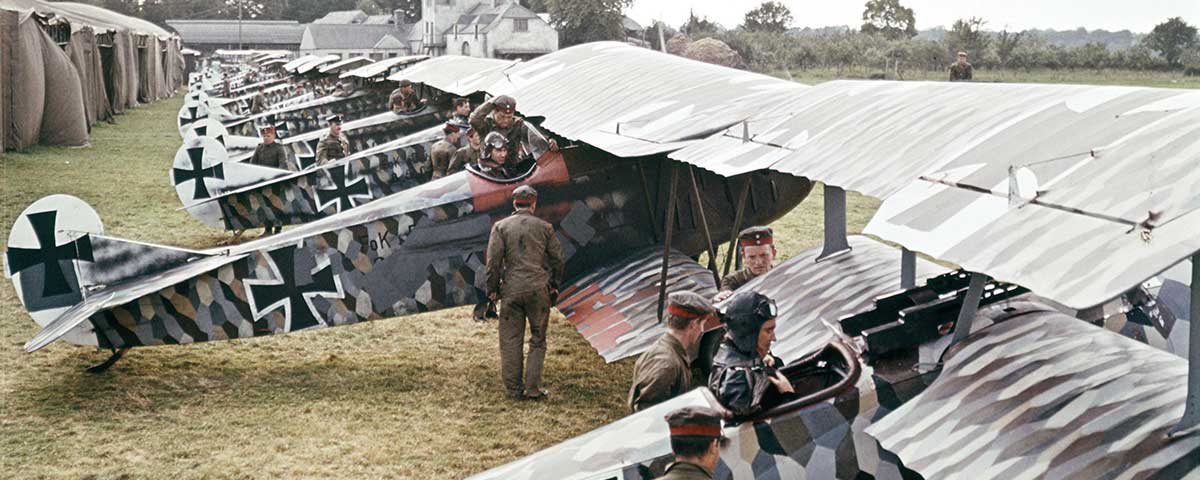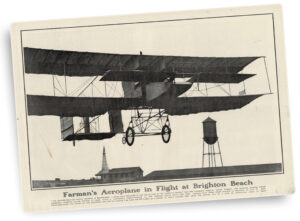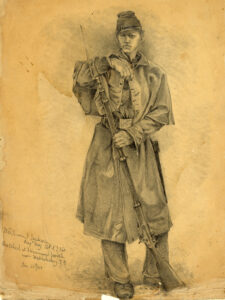Arriving at Ardmore Studios, Dublin, Ireland, in 1965 to begin work on a new 20th Century Fox World War I dogfight movie, stunt pilot Derek Piggott learned he was in for more than just zooming around the skies, popping off smoke bombs and fake bullets while cameras rolled. The script called for a biplane to fly under a bridge, and producer Christian Ferry did not intend to use remote-control models. He meant to make the greatest WWI air combat film of all time: The Blue Max.
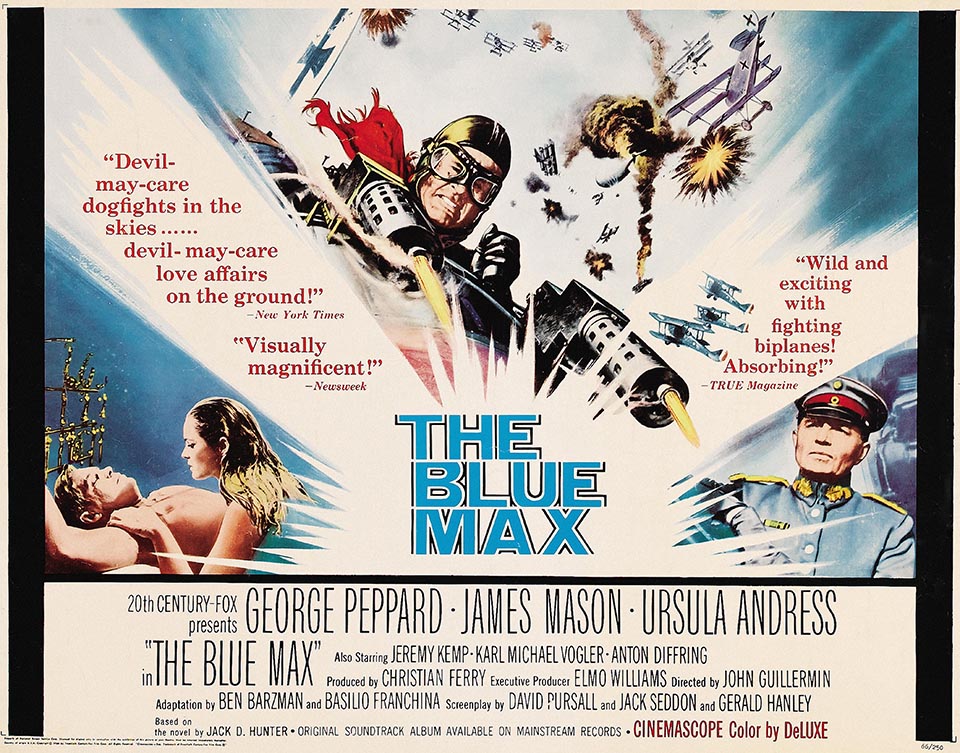
“He must have had photos of almost every bridge in Ireland,” recalled Piggott, who had flown Airspeed Horsa gliders for the RAF in World War II, set a postwar glider altitude record (22,800 feet without oxygen) and broken into movies flying pre-WWI replicas in Those Magnificent Men in Their Flying Machines. “I often wonder now whether Christian showed all the pilots these photos in order to see their reaction, and to try to decide who he would ask to do the job when the time came. Perhaps I was the only pilot who did not say that all the bridges looked quite hopeless.”
Not to mention that the stunt would have to be flown in an airplane virtually hand-built from scratch. Aircraft made of wood and cloth tend to rot, and five decades after the Great War the owners of the few surviving WWI warbirds weren’t inclined to risk them making movies. The Blue Max required Fox to assemble two miniature air forces, at the cost of about a quarter-million dollars—in today’s money, nearly $2 million.
Stunt flier Lynn Garrison, a colorful ex–Royal Canadian Air Force pilot, airshow promoter and aircraft collector, helped assemble the fleet. In German and British paint schemes, a Caudron C.276 Luciole served as a reconnaissance plane for both sides. De Havilland D.H.82 Tiger Moths and a pair of Stampe SV.4Cs with their front cockpits faired over filled out dogfight sequences. A similarly converted French Morane-Saulnier MS.230 stood in for the Fokker E.V parasol monoplane in the film’s final sequence. Meanwhile Bitz Flugzeugbau GmbH of Augsburg, West Germany, built two Fokker Dr.I triplanes, and Rousseau Aviation of Dinard, France, constructed three Fokker D.VII biplanes. Personal Plane Services, in Buckinghamshire, England, built a Pfalz D.III, and the Hampshire Aero Club another. For the “enemy,” Miles Marine and Structural Plastics Ltd. of Shoreham, England, built two S.E.5a scouts.
Given time and material constraints, some sacrifices to authenticity had to be made. The PPS Pfalz was a rebuilt de Havilland Gipsy Moth with a 4-cylinder 140-hp Gipsy Major engine, including a pair of fake cylinders and exhausts to enable it to pass for the original Pfalz’s 160-hp Mercedes inline-6. Similarly, the Bitz triplanes used Siemens-Halske SH-14 radials instead of Oberursel rotaries. Gipsy Queen 3 200-hp 6-cylinder inlines powered both the S.E.5as and D.VIIs; since the Fokkers’ original Mercedes weighed almost twice as much, they required some 200 pounds of nose-ballast for balance. Rousseau named its models the D.VII-65.
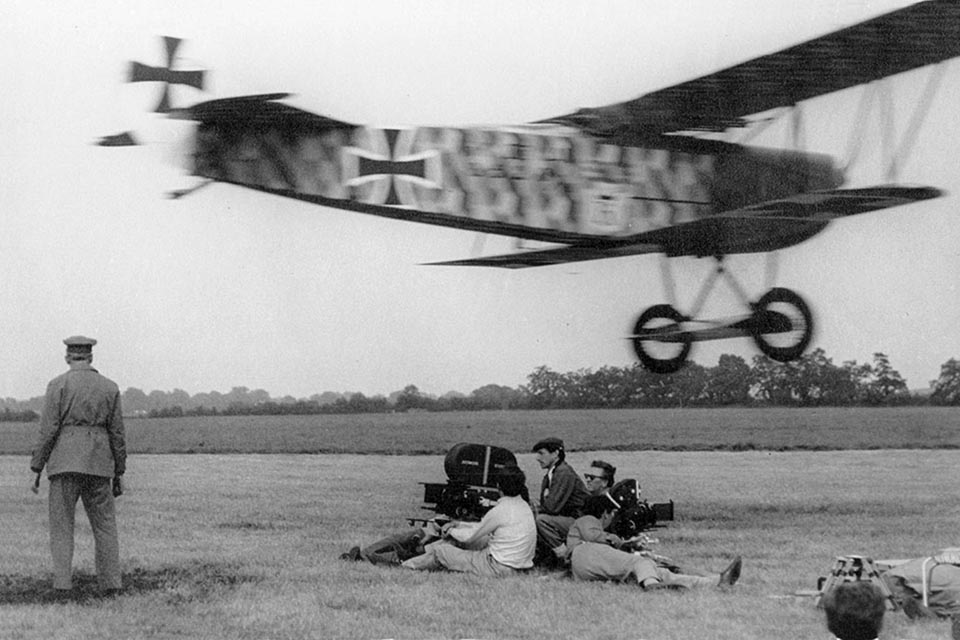
“Most of the aircraft for The Blue Max were constructed in less than five months,” Piggott remembered, “and were flown for the first time only days before the filming began.” There was a friendly competition among the builders to deliver first. PPS took the prize with its Gipsy Pfalz. On the other hand, Rousseau delivered its D.VIIs by actually flying them from France to the set in Ireland—their German crosses and lozenge camouflage no doubt raising eyebrows below.
Anthony Squire, a WWII flying boat pilot who learned movie work with the RAF Film Unit, would direct the air action. German WWI pilot Kurt Delang, with two victories as a senior NCO in Jasta 10, served as technical adviser. Director John Guillermin, thus far best known for Tarzan movies, was determined to make the most of his big break. “Life isn’t really filled with many heroes,” he said of the story, or perhaps the pilots he asked to fly his planes, “but there are men like [main character] Bruno Stachel who strive to achieve greatness against such overwhelming odds that the attempt, to lesser men, must seem not only impossible but madness.”
Star George Peppard took the role of Stachel so seriously that he actually learned to fly. “Before production on The Blue Max, I took an intensive four-month flying course, which gave me 210 hours on my pilot’s log, 130 of them solo,” he reported. “I then checked in at our location in Ireland and spent an additional month flying the re-creations of early aircraft built for the film.” He proved it on the cover of the May 1965 issue of Air Classics magazine, flying a Stampe in German colors.
The PPS D.III reportedly flew well, though with heavy controls. On the other hand, the Hampshire Aero Club’s all-wood Pfalz earned the nickname “Rubber Wings” during filming. The steel-tube S.E.5as were strong and maneuverable, said to be easy to fly, but the D.VIIs were reportedly very heavy and—though their Gipsy Queens ran at twice the rpm of the original Mercedes—underpowered. Likewise the Dreideckers, originally famous for their agility, suffered from the lack of rotary engine torque. Garrison reported, “The [Bitz] triplane has the flying characteristics of a Link Trainer.”
The pilots weren’t the only crew members risking their lives. As a Fokker hopped a tree row, leveled off and rushed the camera, film loader John Earnshaw noticed that he was actually looking down on its wheels. He hit the dirt just before one of them ripped the camera motor out of his hand. Camera operator Chic Waterson was struck on the head, but back at work the next day. Director of photography Douglas Slocombe was hospitalized for three weeks with a wrenched back. 20th Century Fox head of European production and Blue Max executive producer Elmo Williams admitted Guillermin was “indifferent to people getting hurt as long as he got realistic action…a hard-working, overly critical man whom the crew disliked.”
And the idea of a bridge fly-through followed by a crash wouldn’t go away. “Where and exactly why the crash was to occur was not yet determined,” recalled Piggott, “because so much would depend on the location used.” At Carrigabrick, east of the village of Fermoy in County Cork, a railway viaduct of wrought-iron lattice girders spanned the Blackwater River on stone pillars. Carrigabrick Castle, the five-story stone keep at one end, was tall enough to snag a low-flying aircraft for a climactic crash. Garrison flew a test run, and Piggott was told the bridge “had been flown under by the pilots of the RAF in the 1930s,” but he flew down to judge for himself.
“From the filming point of view this bridge was ideal,” the stunt pilot noted, “since it was high enough to allow plenty of room for vertical error. However, this did mean that there could be no question of pulling up and over the top of the bridge once the run had been started.” To minimize horizontal error, Piggott precisely set pairs of scaffolding stakes in the ground, with one right out in the river (visible in the movie, far out ahead of “Willi von Klugermann’s” first fly-through). “Then if the pilot flew toward the bridge keeping the two poles exactly in line,” he reasoned, “he must pass through without any problem.”
Practicing in a Dreidecker at the airfield, though, Piggott found he required several tries to align the poles. “This was worrying,” he said, “since if I did not get through the bridge on the first run, it was immaterial how well I might have done the others.”
The camera ship was a French Aérospatiale SA 318C Alouette II helicopter, flown by Gilbert “Gilly” Chomat, with a cameraman filming from a side mount. Beginning with over-water passes through the bridge’s widest span, Piggott flew 15 successive runs. “Gilbert was able to follow behind me and go through with the helicopter filming all the way,” he recalled. “It was interesting to notice that the ‘take’ selected for the film was not one following the aircraft sedately….In order to make it more exciting the helicopter had been lifted during the run so the triplane appears to duck down under the top of the bridge.”
The next day’s schedule, however, targeted the landward span. “I can remember flying over to the location for the first go under the narrow arch and feeling more like Willi than Stachel,” Piggott wrote. “Circling over the bridge and looking down, the narrow arch looked quite impossible….I was very aware of the fact that the little triplane could not climb over the bridge at the last moment. The biggest danger was the possibility of over-correcting and weaving from side to side.”
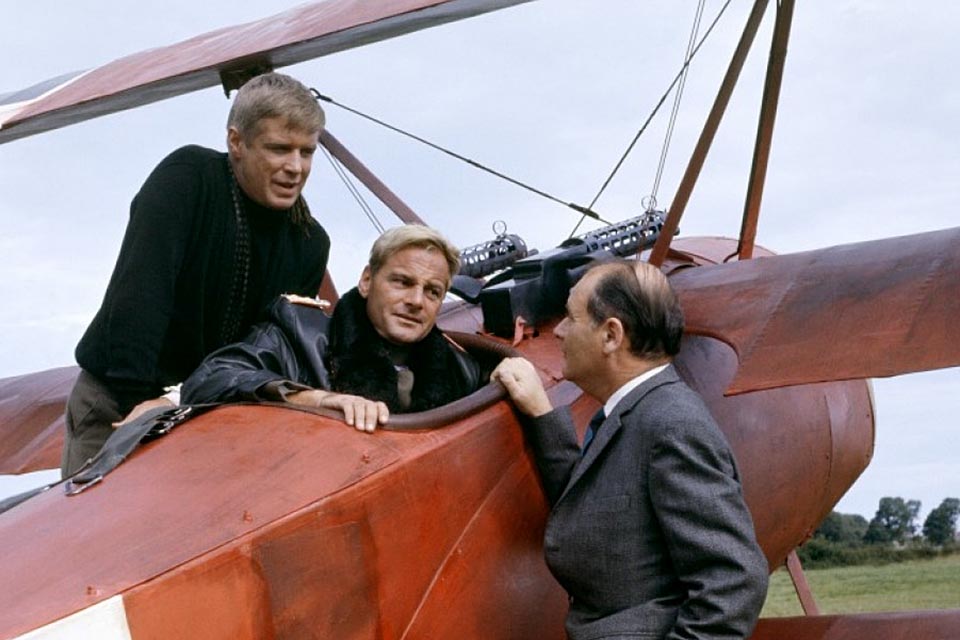
The risk of accidentally performing the scripted crash had everyone on edge. “The film crew had felt the strain of waiting days for this moment,” Piggott recalled; some were “scarcely able to watch the first run.”
“All I had to do,” he knew, “was to settle down quickly on each run and keep those two poles lined up until the bridge had gone by. I made myself oblivious to the huge stone pillars on either side and did not even glance at them.” The Alouette, with a main rotor span 10 feet wider than the Dreidecker’s wings, could not follow. “In many ways I had the easy job,” Piggott said. “All I had to do was fly through the arch, whereas Gilbert flying the helicopter had to both follow me closely and then pull up and over the top of the bridge at the very last moment….By very clever use of the zoom lens…they were able to film the triplane at close quarters and see it go right through the arch.”
Guillermin wasn’t the only stickler for realism. “I was rather afraid that the whole of this episode might be thought to be faked or done with models, and therefore I suggested that we should put a flock of sheep at the foot of the bridge,” Piggott remembered. “On the first few runs the sheep were scared by the noise and moved about very realistically, but they soon became bored with the aircraft and took hardly any notice at all.” Filming also had to pause in mid-flight as a railway truck rolled innocently through the scene, apparently inspecting the track and, as Piggott reported, “happily quite unaware of what was going on.”
“That day I really earned my pay,” he wrote, “with fourteen runs through the narrow arch and two more through the large one. I slept very soundly that night!”
Irish weather prevented flying the third day. Instead the crew mounted a small camera on one of the triplanes to get over-the-shoulder footage. The next day Piggott made two runs wearing Stachel’s helmet, then landed to switch film magazines and don Willi’s helmet. The pass that “kills” Klugermann in the film threatened to kill Piggott. “These last two runs were distinctly exciting,” he understated. “The triplane was buffeted about and I had to bring it back to the center line several times when it had been shifted bodily by the gusts together with the cross wind. This time it was quite a pleasant relief…to know that these were the last runs.”
The crew of The Blue Max not only built and flew their own air forces, they earned $5 million (about $37 million today) at the box office doing it. TV Guide said the film “impressively captures the reality of war in the trenches and in the air.” Perfectionists might quibble, but the Monthly Film Bulletin opined, “The reconstructed S.E.5s, Pfalz D.IIIs and Fokker D.VIIs look as though they were worth the quarter-million dollars spent on them.” Director and warbird enthusiast Peter Jackson (best known for The Lord of the Rings trilogy) calls it one of his favorite WWI movies, and the very best when it comes to the air war. How can any film buff, or aviation buff, think otherwise? CGI artistry simply can’t compete with actual pilots wagering their lives, flying wood-and-wire aircraft just they did at the dawn of aviation. Such scenes are never likely to be captured so well again.
Frequent contributor Don Hollway has written for Aviation History about real WWI aces Max Immelmann (November 2013) and Jean Navarre (November 2012). For further reading, he recommends: Delta Papa: A Life in Flying, by Derek Piggott; and The Blue Max, by Jack D. Hunter. Visit donhollway.com/bluemax for more on the film.
This feature originally appeared in the July 2015 issue of Aviation History. Click here and subscribe!

